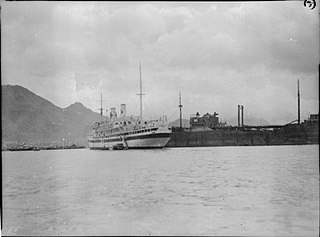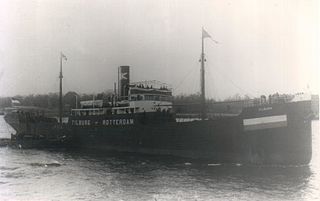
SS John Stagg was a tanker-type (Z-ET1-S-C3) Liberty ship built at the Delta Shipbuilding Company, New Orleans, Louisiana, during World War II. She was named after John Stagg (1864–1915), who was President of Alabama Presbyterian College for Men.
SS Empire Adventure was a 5,787-ton steamship built in 1920 as the Eastney. She was sold to France in 1924 and renamed Germaine L D. In 1931 she was sold to Italy, being renamed Andrea, being seized in 1940 and renamed Empire Adventure. She was torpedoed on the night of 20/21 September 1940 and sank while under tow on 23 September 1940.
SMS Teodo was a 6,561 ton collier built in 1915 for the Austro-Hungarian Navy. She was ceded to Italy in 1921 as a war reparation. She was renamed Barbana in 1924 and Barbana G in 1926. In 1940, she was seized by the United Kingdom and renamed Empire Airman. On 21 September 1940, Empire Airman was torpedoed and sunk by U-100.
Hoxie was a 4,714 ton cargo ship which was built in 1918. She was renamed Empire Albatross in 1940. In 1942, she was renamed Belgian Fisherman. In 1946 she was renamed Belgique and then Martha Hendrik Fisser in 1950. She was scrapped in 1958.
Empire Asquith was a 7,082 ton cargo ship which was built in 1944. In 1947 she was sold and renamed Brockley Hill. Further name changes were Starcrest in 1951, Argosy in 1957 and Nezihi Ipar in 1960. She was scrapped in 1970.
SS Empire Bunting was a 6,318 GRT cargo ship which was built in 1919. She saw service between the wars under the US flag and was transferred to the UK Ministry of War Transport in the Second World War. She made a number of cross-Atlantic voyages, often sailing in convoys. She ended her career by being sunk as a blockship on the Normandy coast, supporting the allied landings there in 1944.
Empire Baron was a 5,890 GRT cargo ship which was built in 1926 for Navigazione Generale Gerolimich & Compagnia Società in Anzioni, Trieste, Italy. She was captured by the Royal Navy in 1940 and ownership passed to the Ministry of War Transport (MoWT). She was renamed Empire Baron. She was sold in 1947 to Navigation & Coal Trade Ltd, London and renamed Rubystone. She was sold to a Panamanian company in 1951 and was scrapped in 1960.

RFA Maine was a 7,432 GRT hospital ship which was built in 1924 as the ocean liner Leonardo da Vinci by SA Ansaldo, La Spezia, Italy for the Società di Navigazione Transatlantica Italiana. In 1941, she was captured by the British at Kismayu, Italian Somaliland. Declared a prize of war, she was passed to the Ministry of War Transport (MoWT) and renamed Empire Clyde, serving as a hospital ship for the British Army during the Second World War. In 1948, ownership was passed to the Admiralty and she entered service with the Royal Fleet Auxiliary as RFA Maine. She served during the Korean War and was scrapped in 1954.
Norhauk was a 6,086 GRT refrigerated cargo ship which was built to Design 1015 by G. M. Standifer Construction Company, Vancouver, Washington in 1919 as Waban for the United States Shipping Board (USSB). After service with Lykes Brothers-Ripley Steamship Co Inc she was transferred to the Ministry of Shipping in 1940 and renamed Empire Sambar. A boiler-room explosion damaged her in 1941. After repairs she was renamed Empire Beaver. She was transferred to the Norwegian Government in 1942 and renamed Norhauk, serving until she struck a mine and sank in December 1943.
Empire Bell was a 1,744 GRT collier which was built by Öresundsvarvet, Landskrona, Sweden as the 2,023 GRT passenger ship Belgia in 1930. In 1940 she was rebuilt as a cargo ship. In 1941, she was damaged by enemy bombing and burnt out. She was salvaged and sold to the Ministry of War Transport (MoWT), repaired and renamed Empire Bell. She was torpedoed and sunk by U-442 on 25 September 1942.
Ravelston was an 2,808 GRT cargo ship which was built in 1906 for the Ravelston Steamship Co Ltd. She was requisitioned by the Ministry of War Transport (MoWT) in 1941 and renamed Empire Bond. In 1946 she was sold and renamed Prenton. Following a grounding in 1949, she was declared a constructive total loss, but was sold and repaired, returning to service as Agios Dionysissios. In 1951 she was renamed Sandenis and then San Denis, serving until she was scrapped in 1959.
Empire Buffalo was a 6,404 GRT Design 1105 cargo ship which was built in 1919 as Eglantine by Skinner & Eddy for the United States Shipping Board (USSB). She was sold in 1933 to the Lykes Brothers-Ripley Steamship Corporation. In 1940 she was sold to the Ministry of War Transport (MoWT) and renamed Empire Buffalo. She was torpedoed and sunk by U-125 in 1942.
Empire Cameron was a 7,015 GRT cargo ship which was built in 1941 for the Ministry of War Transport (MoWT). She was sold in 1946 and renamed St Margaret. In 1960, she was sold and renamed Agna, serving until scrapped in 1963.
SS Empire Chamois was a 5,864 GRT cargo ship which was built in 1918 by Ames Shipbuilding and Drydock Co, Seattle. She was ordered by the Compagnie Générale Transatlantique but was requisitioned by the United States Navy and commissioned as USS West Mount with the pennant number ID-3202 in 1918. She was decommissioned in May 1919 and passed to the United States Shipping Board (USSB) as SS Westmount. In 1927 she was sold to the Dimon Steamship Corporation and renamed SS Pacific Redwood. She returned to the USSB in 1932 and passed to the United States Maritime Commission (USMC) in 1937. In 1940, she was passed to the Ministry of Shipping, passing to the Ministry of War Transport in 1941 and being renamed SS Empire Chamois. She was sold to Astral Shipping Co Ltd in 1946 and renamed SS Granview. In 1949 she was sold to the Compagnia Maritime del Este, Panama and renamed SS Chamois, serving until 1958 when she was scrapped. She was the last Ames-built ship afloat.
Almeria Lykes was a 7,773 GRT Type C3 cargo ship that was built in 1940 by Federal Shipbuilding and Drydock Company, Kearny, New Jersey for the Lykes Brother Steamship Co. She was transferred to the Ministry of War Transport (MoWT) and renamed Empire Condor. In 1942, she was transferred to the United States Maritime Commission (USMC) and renamed Almeria Lykes. She was torpedoed by Axis motor torpedo boats on 13 August 1942 and later scuttled.

Ljusneälf was a 1,391 GRT cargo ship that was built in 1917 as Tilburg by L Smit & Zoon, Kinderdijk for Dutch owners. She was sold to German owners in 1922 and renamed Ljusneälf. A sale in 1938 saw her renamed Hubert Schröder. She was seized by the Allies in April 1945, passed to the Ministry of War Transport (MoWT) and renamed Empire Conquest.
Philips Wouwerman was a 7,091 GRT cargo ship that was built in 1942 as Empire Courage by Barclay, Curle & Co Ltd, Glasgow, United Kingdom. She was built for the Ministry of War Transport. in 1943, she was transferred to the Dutch Government and renamed Philips Wouwerman. In 1947, she was sold into merchant service and renamed Ceram. A further sale in 1953 saw her renamed Amsteltoren and then Amstelbrug. In 1959, she was sold to Greece and renamed Armathia. A further sale in 1965 saw her renamed Calliman. She served until scrapped in 1968.

HMAS Mallina was a 3,213 GRT cargo ship built by Harland & Wolff, Belfast in 1909 as Mallina for the Australian United Steam Navigation Company for the Rockhampton to Sydney cargo route. She was requisitioned by the Royal Australian Navy in 1914, as a store carrier and collier. She was returned to her owners in 1915. She was sold in 1935 to Machida Shokai Kisen Kaisha, Japan and renamed Seiko Maru, before being sold to Kita Nippon Kisen Kaisha and renamed Siberia Maru No. 3, which was later shortened to Siberian Maru. While steaming in the Sulu Sea, Philippines on 24 September 1944, she was attacked by American aircraft of Task Force 38 and sunk with the loss of 158 of the 2,382 people on board.
Empire Engineer was a 5,358 GRT refrigerated cargo ship that was built in 1921 as Canadian Commander by Canadian Vickers Ltd, Montreal, Quebec, Canada. She was sold to an Italian firm in 1932 and renamed Giaocchino Lauro. She was seized by the United Kingdom in 1940, passed to the Ministry of War Transport (MoWT) and renamed Empire Engineer. She served until 4 February 1941 when she was torpedoed and sunk by U-123.
Empire Fusilier was cargo ship which was built as Mincio in 1921 by Cantiere Cerusa, Voltri, Italy for Pietro Ravano Fu Marco, Genoa. She was seized as a prize of war in 1940, passing to the Ministry of Shipping and renamed Empire Fusilier, serving until torpedoed and sunk by U-85 in 1942.



